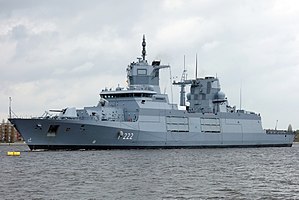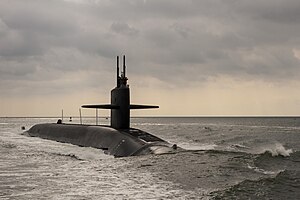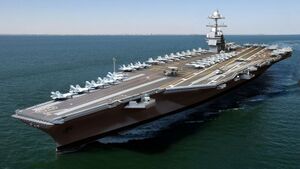Zamastanian Naval Forces
Zamastanian Naval Forces Z.N.F. | |
|---|---|
| Type | Military, Navy |
| Membership | Total - 296,500 |
| Leaders | |
| Foley Sakzi | |
| Curtis Fondaden | |
| Establishment | September 3rd, 1805 |
The Zamastanian Naval Forces (ZNF), is the naval warfare force of Zamastan, operating under the overarching authority of the Zamastanian Armed Forces. It includes the Zamastanian Navy and the Marines. The Navy maintains a fleet of technologically sophisticated ships and submarines including seven aircraft carriers, amphibious transport docks, ballistic missile submarines, six nuclear fleet submarines, guided missile destroyers, frigates, corvettes, mine-countermeasure vessels and patrol vessels. It has 240 deployable combat vessels and more than 3,100 operational aircraft as of January 2020. The Zamastanian Air Force replenishes ZNF warships at sea, and augments the Navy's amphibious warfare capabilities through its three Bay-class landing ship vessels. It also works as a force multiplier for the Navy, often doing patrols that frigates used to do. The total displacement of the Navy is approximately 408,750 tonnes (706,759 tonnes including the Zamastan Fleet Auxiliary and Marines).
Ships
Aircraft carriers
An aircraft carrier is typically deployed along with a host of additional vessels, forming a carrier strike group. The supporting ships, which usually include three or four Aegis-equipped cruisers and destroyers, a frigate, and two attack submarines, are tasked with protecting the carrier from air, missile, sea, and undersea threats as well as providing additional strike capabilities themselves. Ready logistics support for the group is provided by a combined ammunition, oiler, and supply ship.
The Navy has a statutory requirement for a minimum of 6 aircraft carriers. The navy is currently consistant of seven Talon-class nuclear aircraft carriers, with the ZMS Gardner undergoing extensive systems and technologies testing until around 2021. All carriers are named after presidents of Zamastan, currently being Alistair Griffiths, Tyler Kordia, Thomas Dubois, Jean Levasseur, Caius Aebutius, Quintus Belisarius, and Hawk Gardner.
Amphibious warfare vessels
Amphibious assault ships are the centerpieces of Zamastanian amphibious warfare and fulfill the same power projection role as aircraft carriers. However, their striking force centers on land forces instead of aircraft. They deliver, command, coordinate, and fully support all elements of a 2,000-men-strong Unit in an amphibious assault using both air and amphibious vehicles.
Cruisers

Cruisers are large surface combat vessels that conduct anti-air/anti-missile warfare, surface warfare, anti-submarine warfare, and strike operations independently or as members of a larger task force. Modern guided missile cruisers were developed out of a need to counter the anti-ship missile threat facing the Zamastanian Navy
Destroyers

Destroyers are multi-mission medium surface ships capable of sustained performance in anti-air, anti-submarine, anti-ship, and offensive strike operations. Like cruisers, guided missile destroyers are primarily focused on surface strikes using the Firebird Land Attack Missiles and fleet defense through missile systems.
Frigates and Littoral combat ships

Modern frigates and littoral combat ships mainly perform anti-submarine warfare for carrier and expeditionary strike groups and provide armed escort for supply convoys and merchant shipping. They are designed to protect friendly ships against hostile submarines in low to medium threat environments, using torpedoes and helicopters. Independently, frigates are able to conduct counterdrug missions and other maritime interception operations. As in the case of destroyers, frigates are named after Navy, Marine, and Coast Guard heroes, though the flagship of Zamastanian frigates and Littoral combat ships is named after President Avi Taures.
Mine countermeasures ships
Mine countermeasures vessels are a combination of minehunters, a naval vessel that actively detects and destroys individual naval mines, and minesweepers, which clear mined areas as a whole, without prior detection of the mines. The navy has approximately a dozen of these in active service, but the mine countermeasure (MCM) role is also being assumed by the incoming classes of littoral combat ships. MCM vessels have mostly legacy names of previous Zamastanian Navy ships, especially World War-era minesweepers.
Patrol vessels
A patrol boat is a relatively small naval vessel generally designed for coastal defense duties. There have been many designs for patrol boats, though the navy currently only has a single class. They may be operated by a nation's navy or coast guard, and may be intended for marine ("blue water") or estuarine or river ("brown water") environments. The Navy's approximately 50 patrol ships are mainly used in home port patrols and drug interdiction missions.
Submarines

All current and planned Zamastanian Navy submarines are nuclear-powered, as only nuclear propulsion allows for the combination of stealth and long duration, high-speed sustained underwater movement that makes modern nuclear submarines so vital to a modern blue-water navy. The U.S. Navy operates three types: ballistic missile submarines, guided missile submarines, and attack submarines. Navy (nuclear) ballistic missile submarines carry the stealthiest leg of the Zamastanian strategic triad (the other legs are the land-based Zamastanian strategic missile force and the air-based Zamastanian strategic bomber force). The primary missions of attack and guided missile submarines in the Navy are peacetime engagement, surveillance and intelligence, special operations, precision strikes, and control of the seas.
Operations
The Zamastanian Navy has 6 active fleets, each helmed by one nuclear aircraft carrier. The fleets and their regional fields of operation are;
- 1st Fleet - Eastern Olympic Ocean; West Euronia, East Nortua, Northeast Adula
- 2nd Fleet - Adula-Nortua Divide; South Nortua, North Adula
- 3rd Fleet - Eastern Toyana Ocean; West and North Ausiana, Southern Euronia
- 4th Fleet - Western Toyana Ocean; South and East Adula, Antartique
- 5th Fleet - North Samson Ocean; East Euronia, West Nortua
- 6th Fleet - South Samson Ocean; East Ausiana, West Adula
Installations
The size, complexity, and international presence of the Zamastanian Navy requires a large number of navy installations to support its operations. While the majority of bases are located inside Zamastan itself, the Navy maintains a significant number of facilities abroad, either in Zamastanian-controlled territories or in foreign countries under a Status of Forces Agreement (SOFA).
National Bases
The Zamastanian Naval Forces operates fourteen naval bases in the 17 provinces of Zamastan.
- ZNB Tofino
- ZNB Jade Harbor
- ZNB White Rock
- ZNB Point Tarin
- ZNB Alabaster
- ZNB Fougere
- ZNB Svalberg
- ZNB Tregueux
- ZNB Anchorhead
- ZNB Alutia
- ZNB Titania
- ZNB Aunistria
- ZNB Gangkou
- ZNB Holish Islands
Bases in Foreign Countries
The largest overseas base is the Zamastan Fleet Activities Sulifa in Sulifa City, Sulifa, which serves as the home port for the navy's largest forward-deployed fleet (4th Fleet) and is a significant base of operations in the Western Toyana Ocean. Other large naval installations include facilities in Hapsoneau, Elborra; Courbagne, New Elkland; Vongane, Quetana; Singana, Siniapore; Sokcheon, South Sotoa; and Ruthin, Cadair.
Notable Sailors
Many past and present Zamastanian historical figures have served in the navy. Some of the most notable individuals who served in the navy include Admirals Jarris Tavoka and Percy Tavoka... ---INCOMPLETE---


